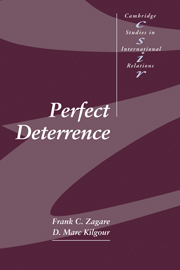Book contents
- Frontmatter
- Contents
- List of figures
- List of tables
- Preface
- Part I Theoretical underpinnings
- 1 Classical deterrence theory
- 2 Rationality and deterrence
- 3 Credibility and deterrence
- Part II Direct deterrence
- Part III Extended deterrence
- Part IV Implications
- Appendices
- 1 Deterrence models
- References
- Index
- CAMBRIDGE STUDIES IN INTERNATIONAL RELATIONS
2 - Rationality and deterrence
Published online by Cambridge University Press: 01 October 2009
- Frontmatter
- Contents
- List of figures
- List of tables
- Preface
- Part I Theoretical underpinnings
- 1 Classical deterrence theory
- 2 Rationality and deterrence
- 3 Credibility and deterrence
- Part II Direct deterrence
- Part III Extended deterrence
- Part IV Implications
- Appendices
- 1 Deterrence models
- References
- Index
- CAMBRIDGE STUDIES IN INTERNATIONAL RELATIONS
Summary
A rational strategy for the employment of nuclear weapons is a contradiction in terms.
Robert JervisThe consensus view of classical deterrence theory is deficient, both empirically and logically. Empirically, the theory is hard put to explain, inter alia, the stability of the Cold War period before the Soviet Union achieved essential equivalence with the United States, the absence of an all-out conflict between the Soviet Union and China, especially during the most contentious stretches of this strategic relationship, and the historical tendency of major-power wars to occur under parity conditions. Logically, the theory is marred by a fundamental incompatibility between its tenets and the canons of rationality. This is the paradox of mutual deterrence. More specifically, logic implies that the status quo should unravel as higher and higher costs render mutual conflict worse and worse for both sides. Classical deterrence theory, however, asserts the opposite.
States clearly do not always behave the way classical deterrence theory suggests they do or should. Waltz (1993: 53–54) notwithstanding, the glaring discrepancy between logic and fact, between prescription and description, is troubling. Accordingly, in this chapter and the next, we inquire whether classical deterrence theory can be resuscitated, that is, whether it can be rendered logically coherent and, ultimately, empirically accurate. To this end, we now explore the merits of three potential resolutions of the paradox of mutual deterrence that attempt to explain general deterrence stability without violating the rationality postulate: deterministic threats, “threats-that-leave-something-to-chance,” and a solution suggested by the theory of metagames.
- Type
- Chapter
- Information
- Perfect Deterrence , pp. 37 - 64Publisher: Cambridge University PressPrint publication year: 2000



